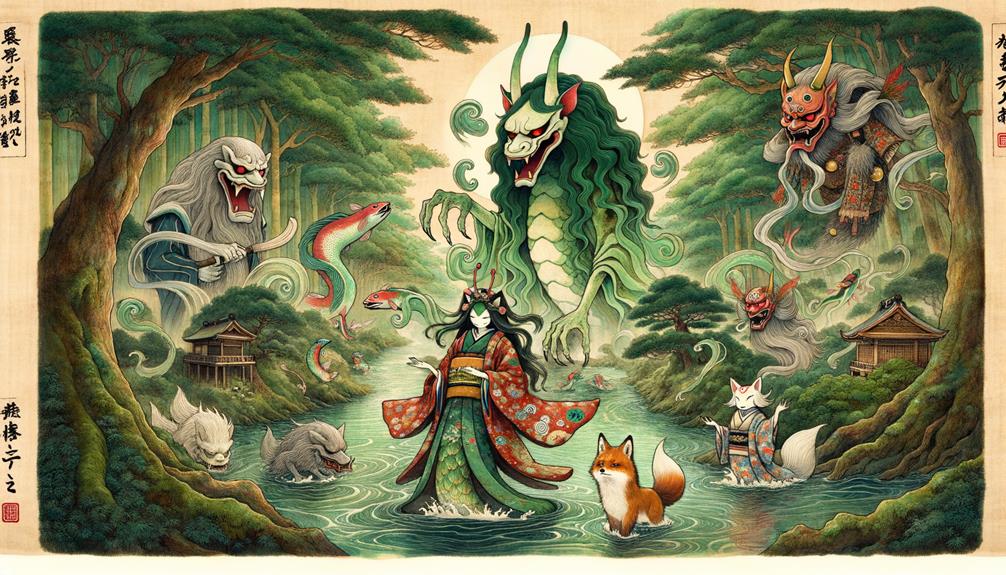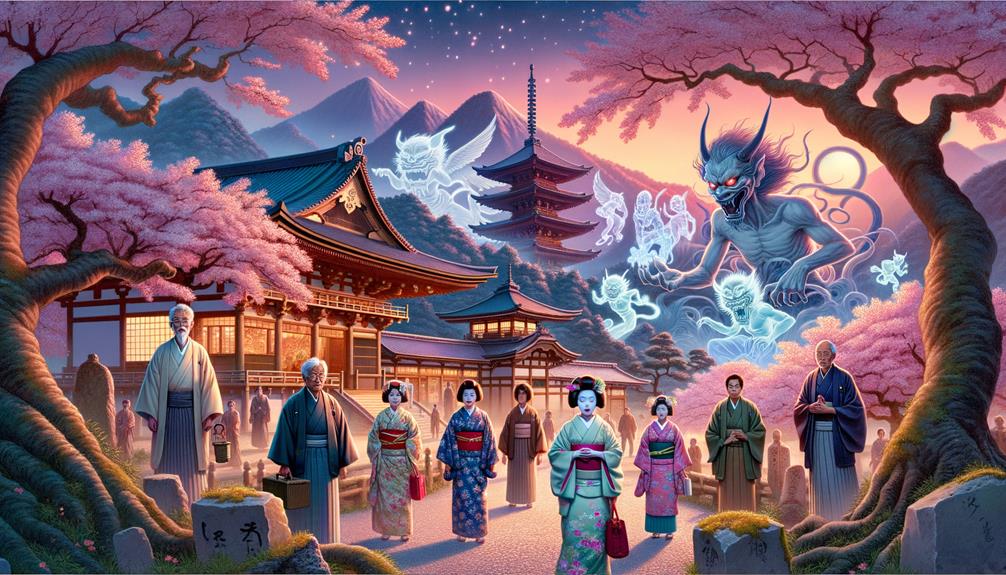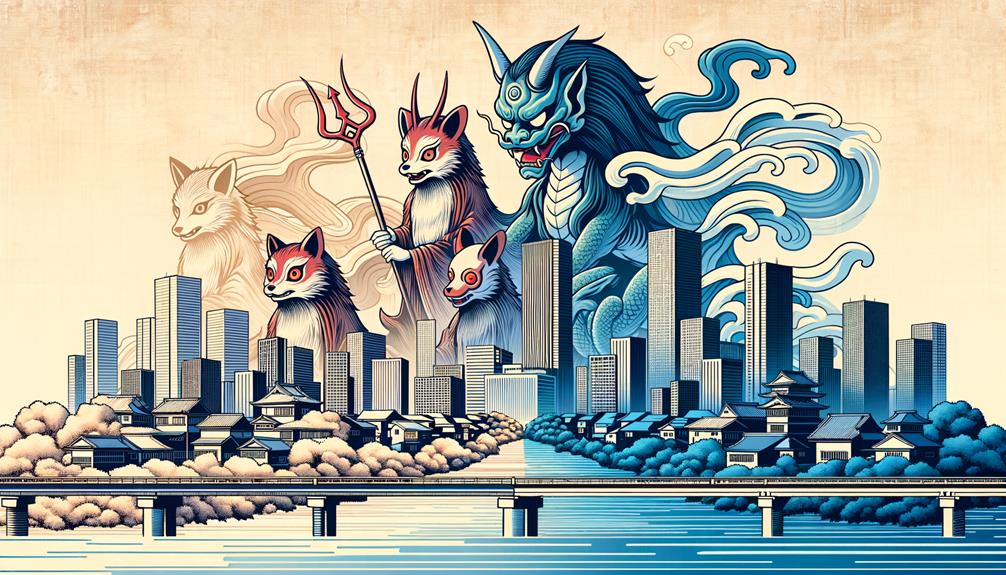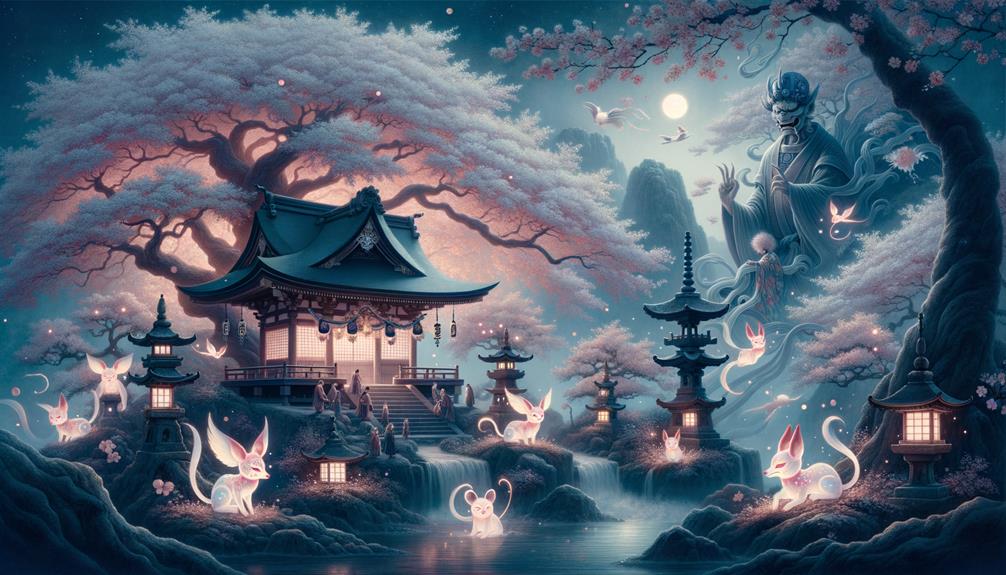So, do you think there's any truth to the idea that Yokai, these often misinterpreted spirits from Japanese mythology, are a reflection of our own human complexity? I can tell you, I've poured over historical documents, wrapped up in the mystery and charm of these ghostly figures. What I've found is that Yokai, much like us, display a range of traits from harmless to harmful, from playful to kind. This complex nature of theirs shakes up our simple view of good versus evil, encouraging us to admit that life, like the Yokai, isn't just black or white but exists in shades of gray. So, let's dive into the fascinating world of Yokai together, and who knows? By getting to know them, we might just get to know ourselves a little better too.
Origins of Yokai in Japanese Folklore

Let's chat about the origins of Yōkai in Japanese folklore. Yōkai are supernatural entities thought to embody natural phenomena and objects. They gained popularity during the Edo period, with artists skillfully creating new yōkai from folk tales and their creative minds. Folks believed that everything, from the wind rustling leaves to the quiet stone by the road, was part of the yōkai world. These Japanese spirits, respected and feared, were seen as folklore creatures with the ability to bring both blessings and curses.
During the Heian period, story collections about these supernatural beings started to circulate. These tales, accompanied by visual representations from the Middle Ages, turned the yōkai from vague ideas into palpable figures. However, as Japan modernized during the Meiji restoration, interest in yōkai declined. It was only when manga artist Shigeru Mizuki revitalized the yōkai through his comic series 'GeGeGe no Kitaro' that these spirits reclaimed their standing in the Japanese imagination. It was a powerful reminder of the enduring appeal of the yōkai in Japanese culture.
Classification and Types of Yokai

Continuing our journey into the intriguing universe of yōkai, we find it interesting to uncover the complexities in their categorization and the variety in different types of these mysterious beings. Yōkai, in traditional Japanese lore, are spirits and monsters that can appear in an array of forms. This extensive history of classification is diligently recorded in Toriyama's Yokai Encyclopedias.
Looking closer at how yōkai are classified and their various types, we find that they're not simply evil spirits. They are a wide range of beings that represent different aspects of nature and human emotions. For example, Kitsune are playful fox spirits, whereas Oni are demon-like creatures recognized for their fierceness. Japanese yōkai also include Tengu, avian mountain spirits, and Kappa, water dwellers known for their pranks.
Getting to know them isn't just about surviving encounters with Japanese monsters; it's about appreciating a unique cultural perspective to interpret strange phenomena. Each yōkai has its own story, contributing to the world they live in. The variety in the categorization of yōkai reflects the complex fabric of Japanese folklore. Their lasting impact on contemporary culture continues to draw us in.
Cultural Influence of Yokai

When we talk about cultural influences, it's really interesting to see how much yōkai – traditional Japanese spirits and monsters – have become part of Japanese literature, art, and entertainment. These figures from folklore and mythology are deeply woven into the fabric of Japanese society and really help to shape its distinctive traits.
Out of the 57 different kinds of supernatural beings recognized in Japanese mythology, yōkai are particularly noticeable. We can spot them across a range of different platforms:
- GeGeGe no Kitaro, a popular manga series, introduces yōkai to a younger audience.
- Yōkai often make an appearance in traditional Japanese art, highlighting their cultural and historical importance.
- The 'Parade of One Hundred Monsters', a well-liked event, lets people see yōkai in action.
- Modern video games and anime often feature yōkai, showing how well-loved they still are.
- There's a wide range of yōkai-themed products on offer, which really underlines their commercial significance as well as their cultural impact.
So, yōkai aren't just an influence on traditional monster lore and culture in Japan. They're also playing a big part in shaping contemporary Japanese society. Their ongoing popularity shows just how much the supernatural continues to intrigue the Japanese.
In a nutshell, the enduring appeal of yōkai in Japan shows that these mythical creatures are as relevant today as ever. They are deeply ingrained in the Japanese consciousness, demonstrating the country's long-standing fascination with the supernatural.
Famous Yokai in Literature and Art

Let's take a fun journey through the rich and colourful world of Japanese literature and art. Here, you'll meet some mesmerizing yōkai like the Tengu, Kitsune, Kappa, and Oni. These aren't just any creatures, they're a vital part of Japanese folklore and mythology, and they've deeply enriched Japan's cultural stories, from age-old paintings to the latest manga and anime.
Take the Tengu, for example. This fella, known for his long nose and wings, is a regular feature in Utagawa Kuniyoshi's woodblock prints. Then there's the crafty Kitsune, often shown in shapeshifting forms. You'll find this one in the works of Toriyama Sekien, especially his Illustrated: The Yokai Encyclopedias. And let's not forget the Kappa, the water-loving yōkai. You'll often spot this character in the Night Parade of One Hundred Demons, a hot theme in Japanese art.
And guess what? These yōkai aren't just a thing of the past. They managed to stick around even after World War II, and they're still making waves in modern Japanese pop culture. Manga artists frequently pull ideas from these beings, giving them a fresh, modern spin. The term for these spirits has even entered the global language, all thanks to the worldwide love for manga and anime.
Misunderstandings and Modern Interpretations of Yokai

Yōkai, despite having deep historical roots, are often misinterpreted, and their depiction in today's culture can be wildly different from the traditional Japanese folklore. You'll see this when you look at their presence in video games where they've become incredibly popular.
Michael Dylan, a noteworthy scholar from the University of California Press, among other East Asian experts, has pointed out some glaring inconsistencies in recent years:
- The change of yōkai from frightful beings of the warring states era to adorable video game characters.
- The overstatement of yōkai powers and skills beyond what's described in their traditional folklore.
- The misinterpretation of yōkai origins that are usually tied to specific geographical locations in Japan.
- The oversimplification of yōkai categories, which are intricate and multifaceted in traditional folklore.
- The erasure of the moral and social lessons that are a fundamental part of traditional yōkai stories.
Take, for instance, the 'Hundred Demons' portrayed in the Woodblock Print art style, clearly different from their video game versions. Grasping these inconsistencies helps us better understand yōkai and how their cultural significance has changed over time. As yōkai keeps drawing in audiences worldwide, it's crucial to remember their rich, historical background.
Frequently Asked Questions
What Is the Belief in YōKai?
You know, yōkai really are intriguing. They're part of Japanese folklore and represent both good and bad spirits. You'll find them in so many things, from natural phenomena to city myths. Even today, they still have a strong presence in our culture.
What Is a YōKai Spirit?
So, you're curious about the yōkai spirit, huh? Well, steeped in Japanese folklore, this is not your run-of-the-mill kind of spirit. Yōkai spirits are supernatural, existing beyond the realm of the ordinary. Now, they're not always the bad guys. Some can be friendly, while others might give you a bit of a hard time. Often, they're seen as the personification of natural events or elements. And no, they're not your typical demons. In fact, some might surprise you with their animal-like features, while others might look remarkably like us humans. Intriguing, isn't it?
What Is the Strongest YōKai Spirit?
"Strength is king," they say, and in the realm of yōkai spirits, nothing rings truer. The oni, a creature that's more demon than ghost, stands head and shoulders above the rest. Its unrivaled power and the ability to take on different forms are impressive, to say the least. But what really sets the oni apart is its capacity to bring about calamities, making it the most powerful yōkai spirit of them all.
What Is the Difference Between a Ghost and a YōKai?
So, you're wondering about the distinction between a ghost and a yōkai, right? Well, it's pretty simple. Ghosts are, essentially, the souls of people who've passed on. Yōkai, on the other hand, are a bit more complex. They're supernatural beings from Japanese folklore. They can represent all sorts of things – from natural events to everyday objects, and even ideas.

